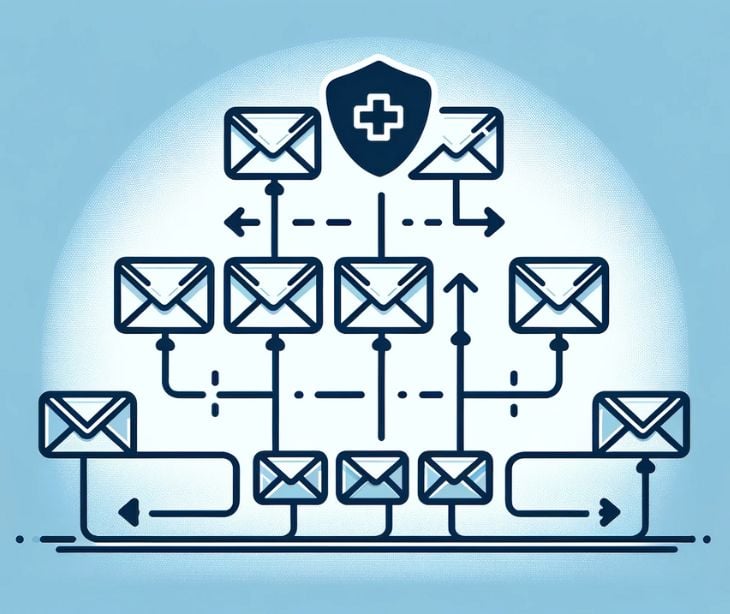
Handling electronic protected health information (ePHI) is divided into two distinct processes, each supported by encryption: storage and transmission. An IEEE Transactions on Information Technology in Biomedicine study notes, “Encryption is the most powerful and common approach to protect information confidentiality. It can make the PHI unreadable during storage and transmission.”
Storage of ePHI refers to the retaining of healthcare information in various electronic forms, such as on servers, in the cloud, or on other digital media. On the other hand, transmission of ePHI involves the movement of this data across electronic networks, such as when sending patient information via email or sharing it between healthcare providers.
The specific HIPAA requirements for storing ePHI
Physical safeguards for ePHI storage
- Facility access and control: Limit physical access to facilities where ePHI is stored, ensuring only authorized personnel have access.
- Workstation and device security: Implement policies and procedures for the proper use and security of workstations and electronic devices that store ePHI.
- Physical protection: Use locks, security systems, and environmental controls (like fire suppression and climate control) to protect against unauthorized access, theft, and environmental hazards.
Technical safeguards for ePHI storage
- Access control: Implement procedures to ensure only authorized personnel can access ePHI, including unique user identifications, emergency access procedures, and automatic logoff settings.
- Audit controls: Implement hardware, software, and/or procedural mechanisms to record and examine access and other activity in systems containing ePHI.
- Integrity controls: Ensure ePHI is not improperly altered or destroyed, possibly through electronic mechanisms that corroborate data quality and consistency.
- Transmission security: Protect ePHI that is electronically transmitted over an open network from unauthorized access, primarily through encryption.
Administrative safeguards for ePHI storage
- Security management process: Implement policies and procedures to prevent, detect, contain, and correct security violations (e.g., risk analysis and management).
- Information access management: Ensure that access to ePHI is appropriate and authorized, including policies for granting access to ePHI.
- Workforce training and management: Train staff on the secure handling of ePHI and apply sanctions to employees who fail to comply with security policies.
HIPAA requirements for the transmission of ePHI
Encryption requirements for ePHI transmission
- Encryption of data in transit: HIPAA mandates that ePHI must be encrypted while it is being transmitted over electronic networks. This means converting the data into a coded format that can only be read by someone who has the key to decrypt it.
- Use of standard encryption protocols: Organizations should use recognized and strong encryption standards, such as Transport Layer Security (TLS) or Secure Socket Layer (SSL), to secure ePHI during transmission.
Integrity control requirements
- Maintaining data integrity: HIPAA requires measures to be in place to ensure that ePHI is not improperly altered or destroyed during transmission. Integrity controls verify that the information sent is the same as the information received.
- Checksums and digital signatures: Techniques like checksums and digital signatures are commonly used to fulfill this requirement. They help in detecting any changes or tampering that might occur during the data transmission process.
Necessity of secure communication channels
- Protection against unauthorized access: Secure communication channels like HIPAA compliant email are necessary to protect ePHI from being accessed by unauthorized individuals. These channels prevent potential data breaches and cyber attacks.
- Ensuring confidentiality and trust: Secure transmission upholds patient confidentiality and trust, beneficial elements in the healthcare provider-patient relationship.
- Compliance with legal and ethical obligations: Secure transmission is not just a technical necessity; it's also a legal and ethical obligation for healthcare providers to protect patient information.
- Risk management: Using secure channels is part of a broader risk management strategy to mitigate potential security incidents that could lead to data breaches and the resulting penalties and loss of reputation.
The difference between storage and transmission
The separation of HIPAA requirements relating to storage and transmission aspects adds layers of complexity to the software development and selection process. For storage, software must not only secure ePHI against unauthorized access but also ensure its integrity and availability through backups and disaster recovery solutions. In transmission, the focus shifts to robust encryption protocols and real-time data integrity checks. This dichotomy requires healthcare organizations to either invest in multiple specialized solutions or seek comprehensive platforms that adequately address both sets of requirements.
FAQs
What are the different types of data transmission?
The main types include simplex (one-way), half-duplex (two-way but alternating), and full-duplex (simultaneous two-way communication).
What is the difference between synchronous and asynchronous transmission?
Synchronous transmission uses clock signals for precise timing, while asynchronous transmission employs start and stop bits to manage data flow without a clock signal.
What factors affect data transmission rates?
Factors include bandwidth, latency, network congestion, error rates, and the quality of the communication medium.
Subscribe to Paubox Weekly
Every Friday we'll bring you the most important news from Paubox. Our aim is to make you smarter, faster.




